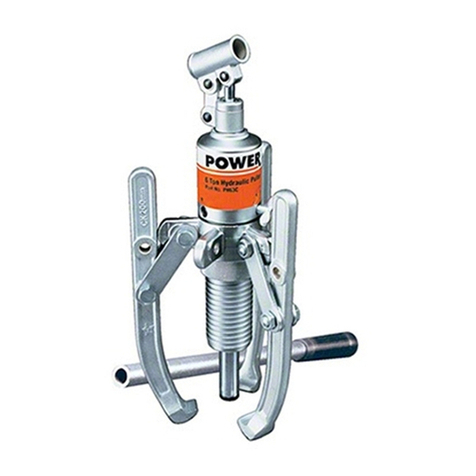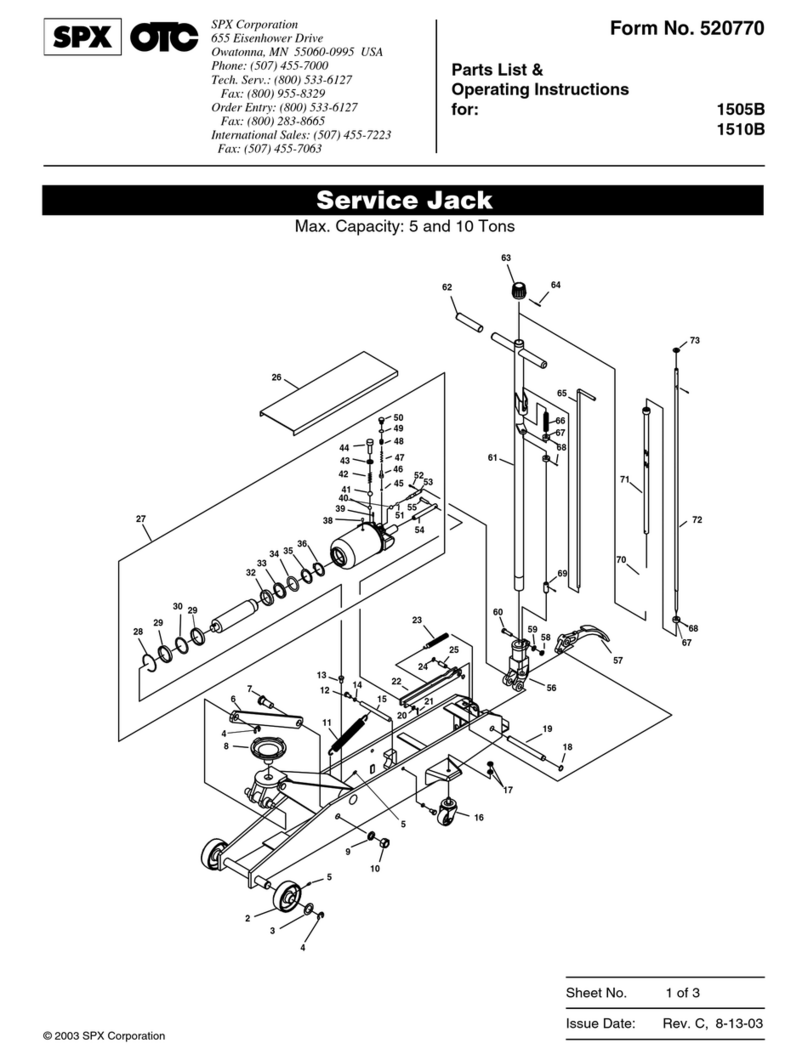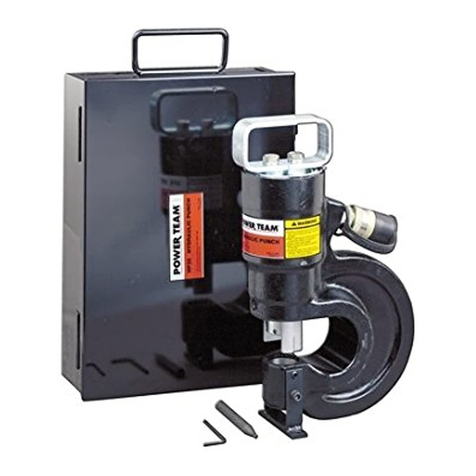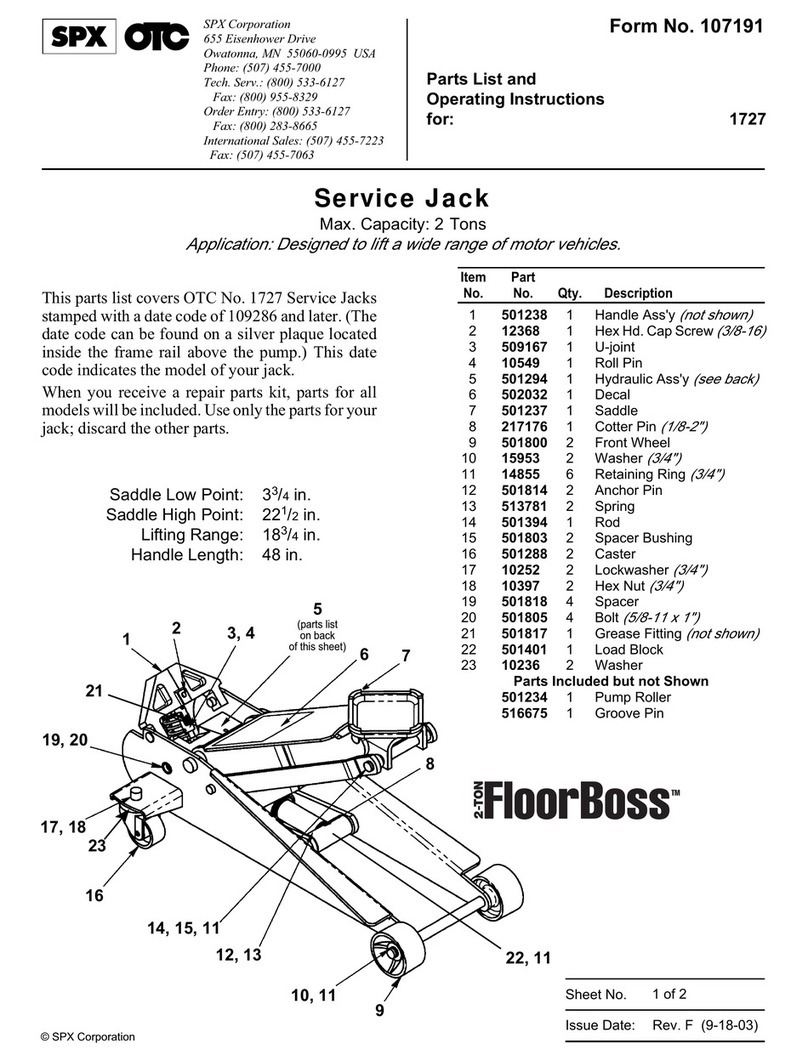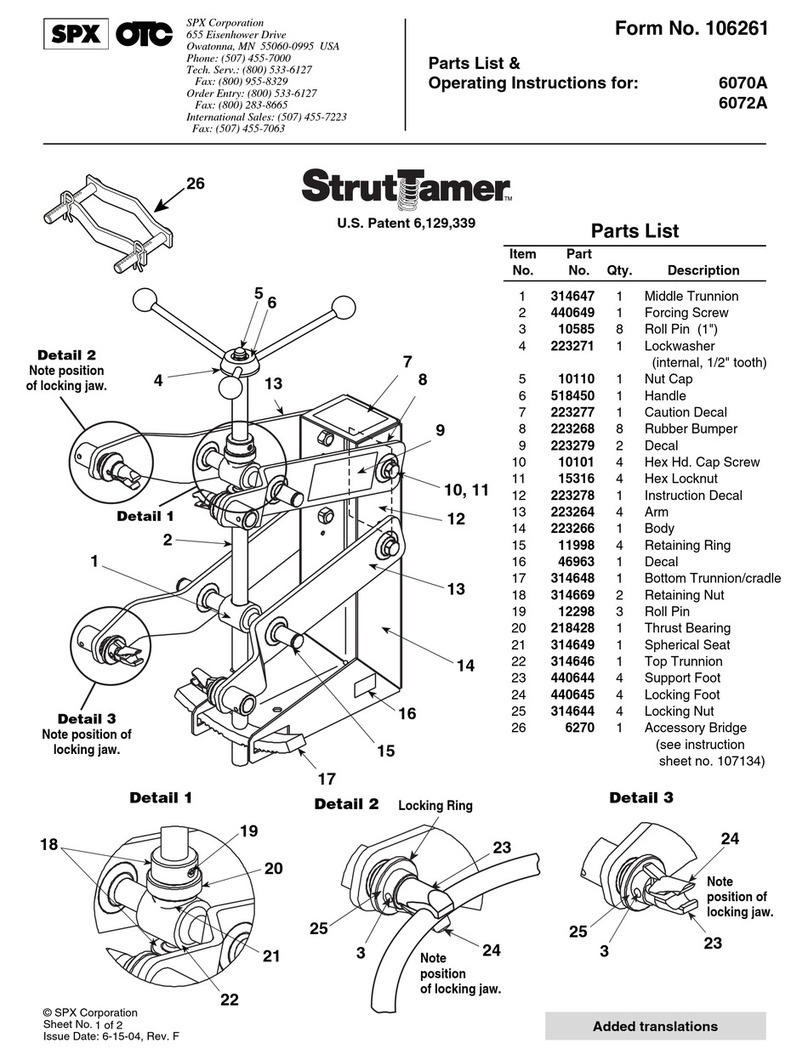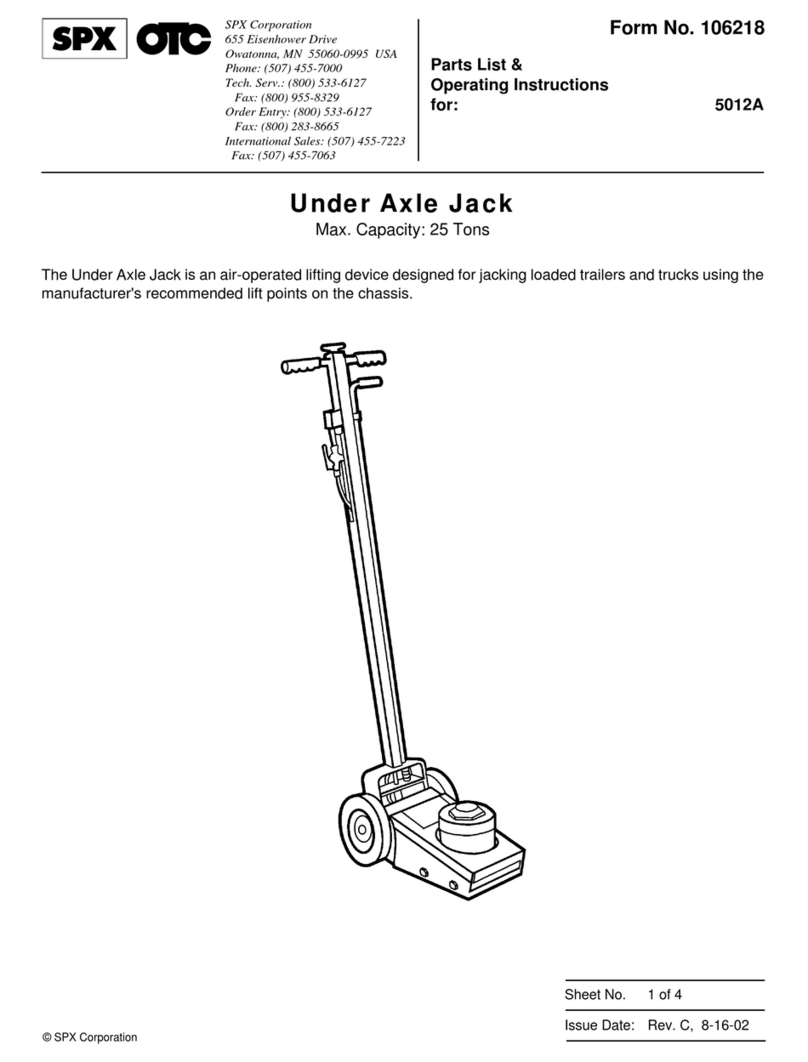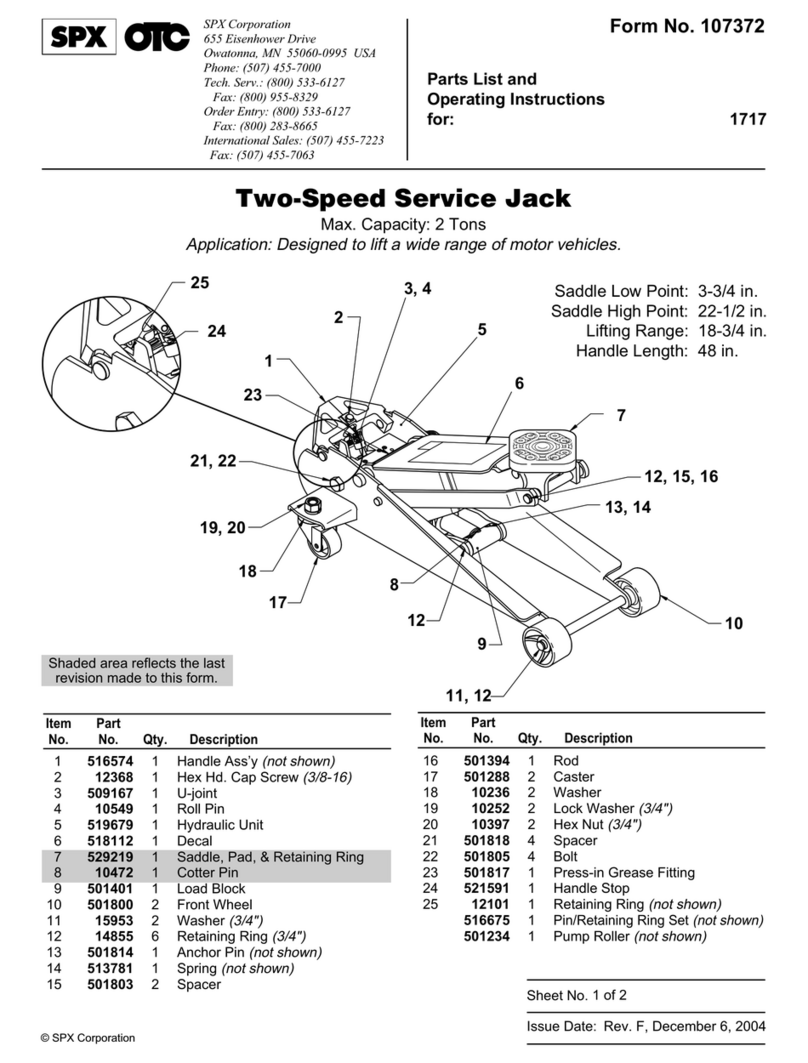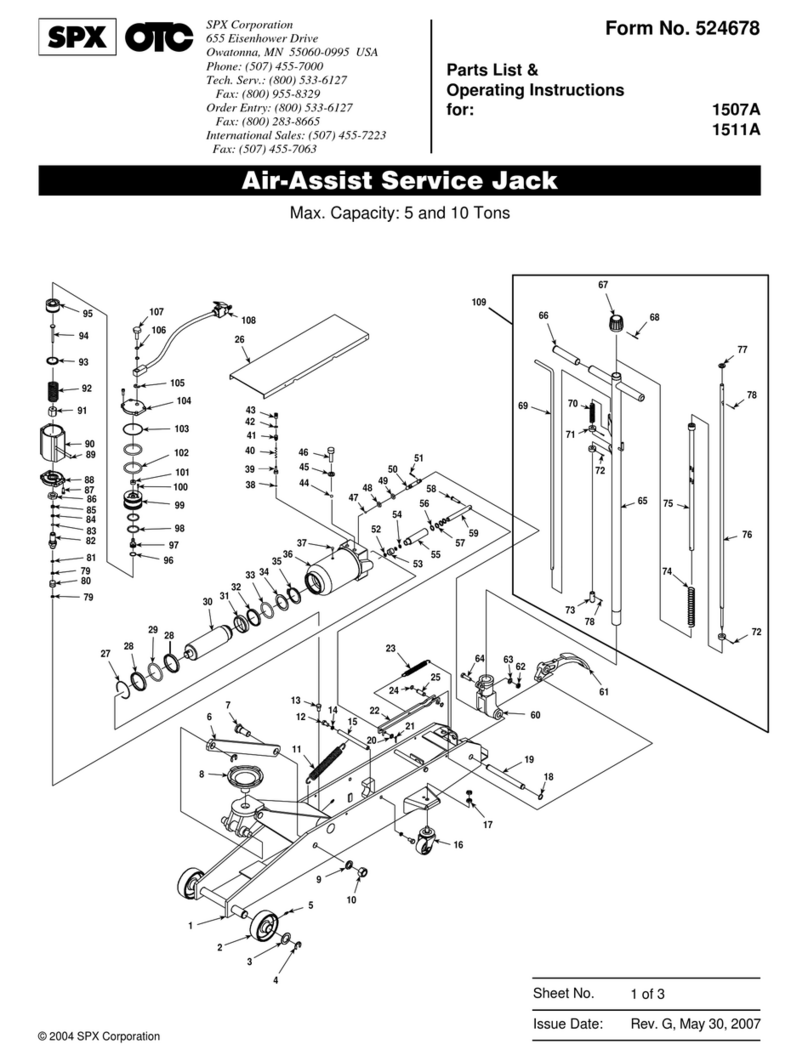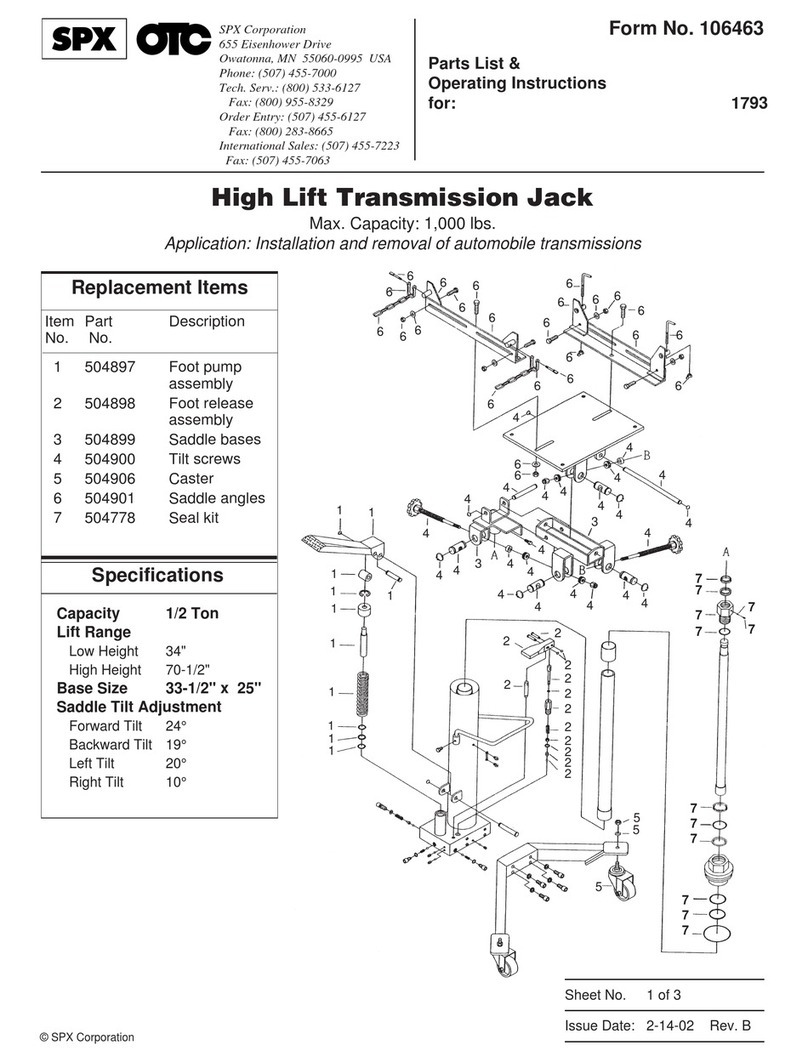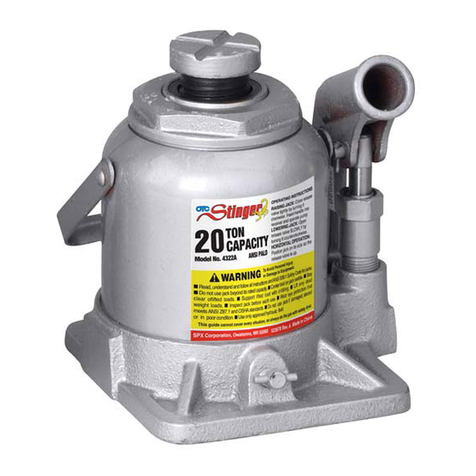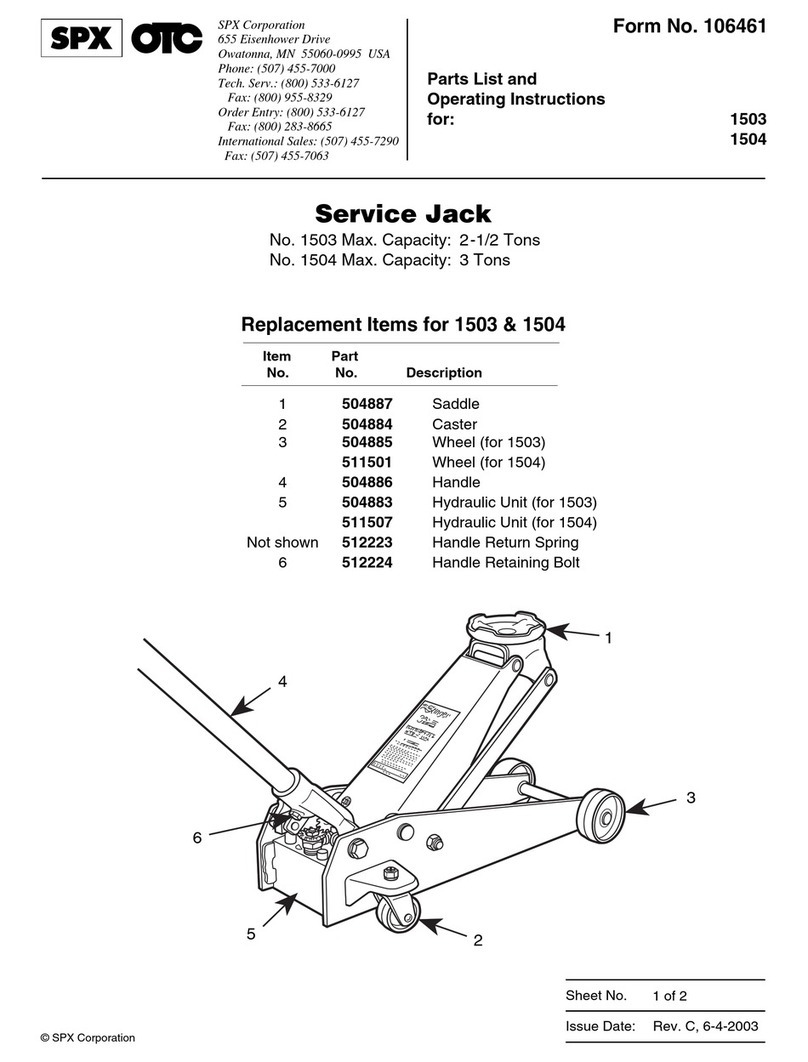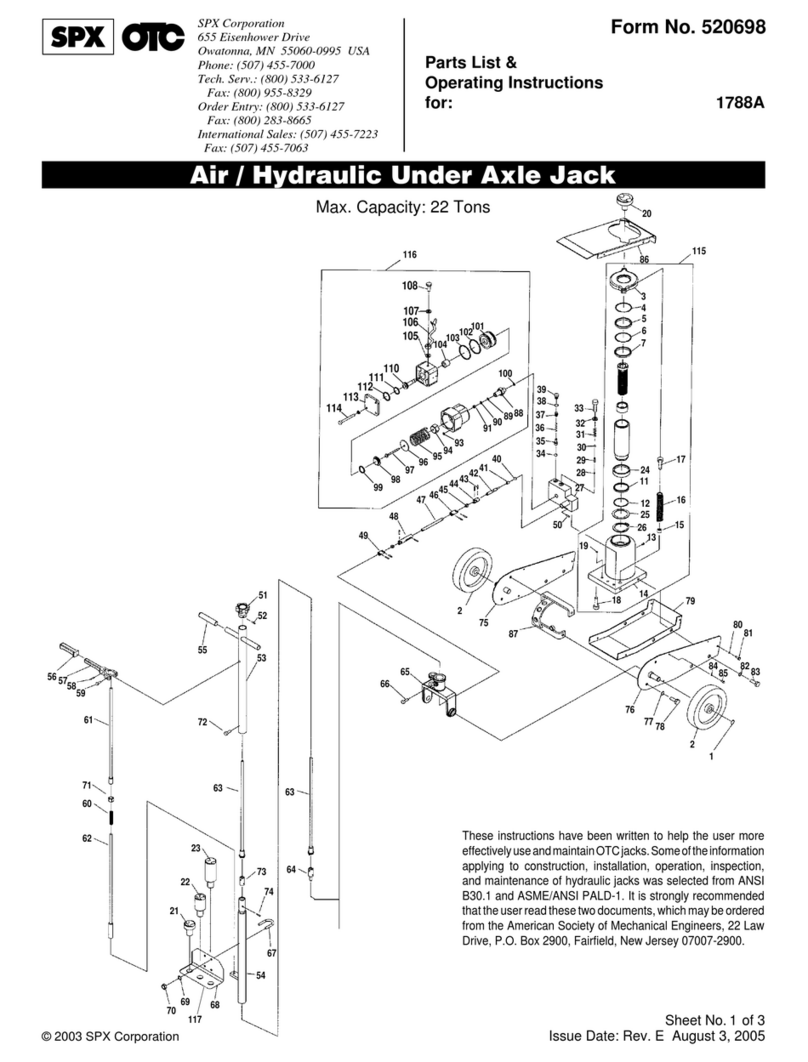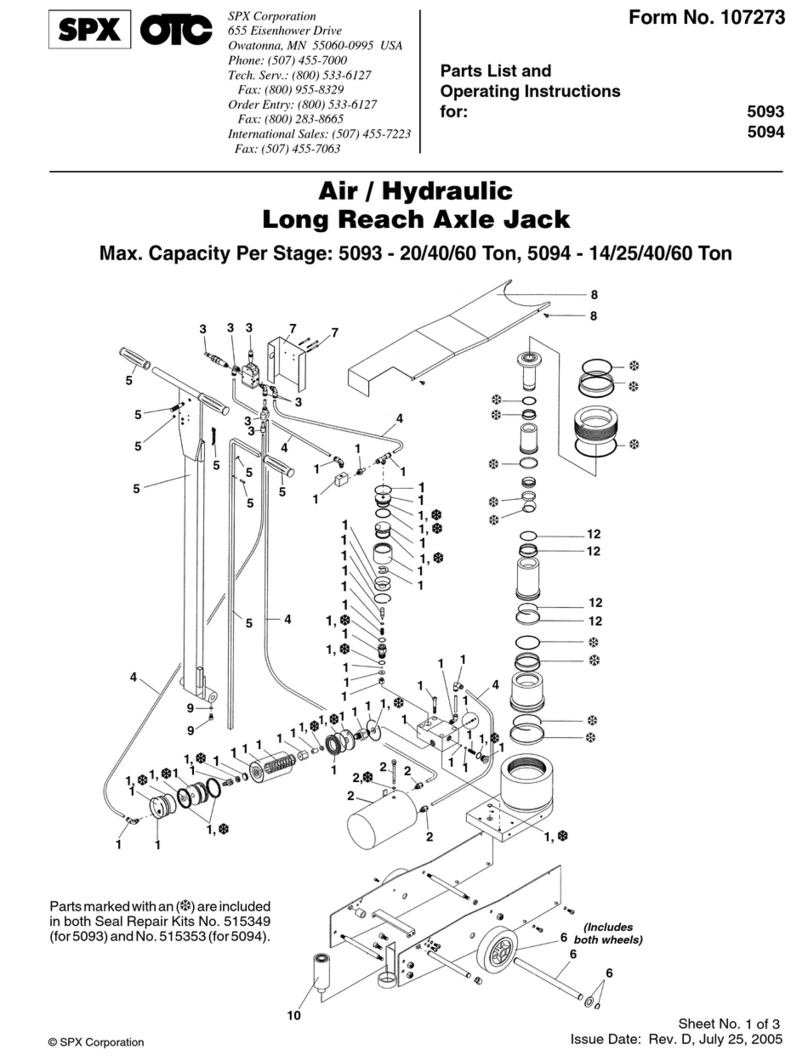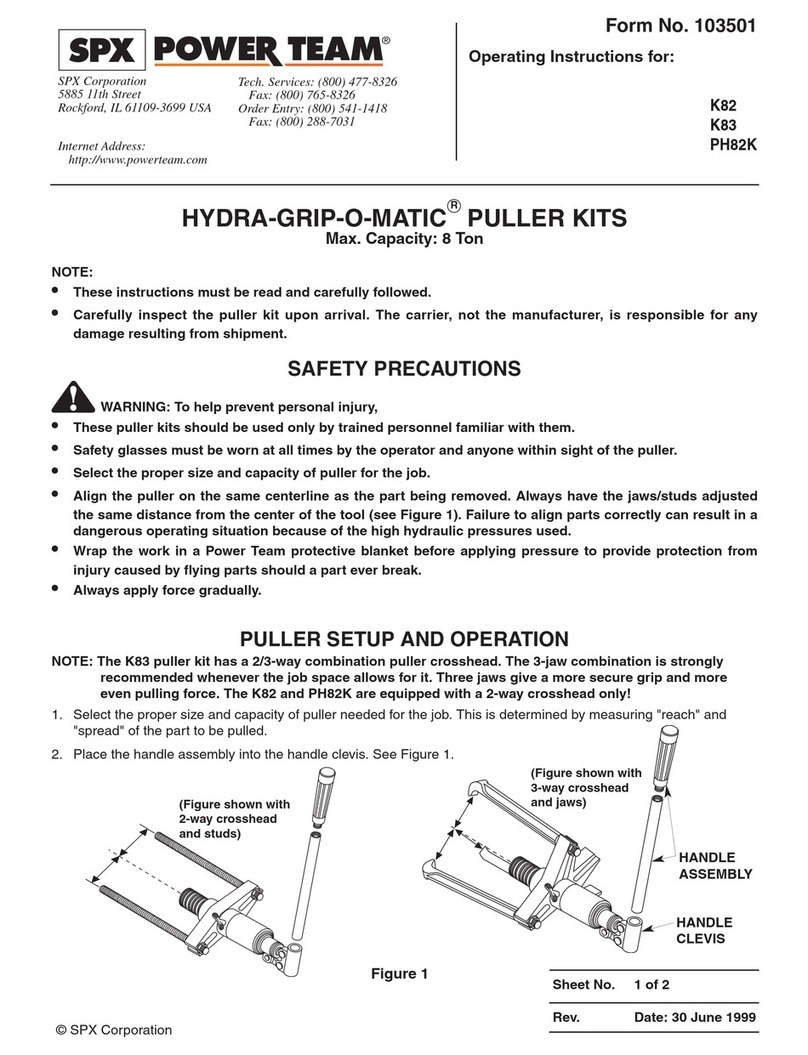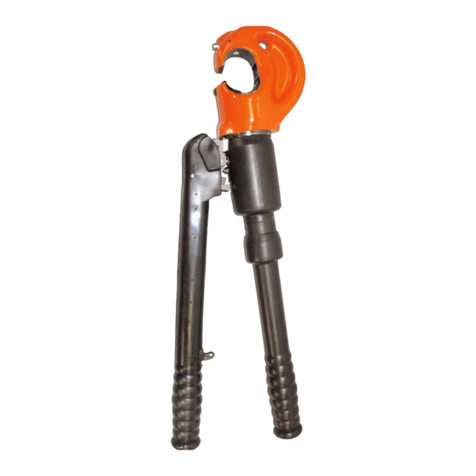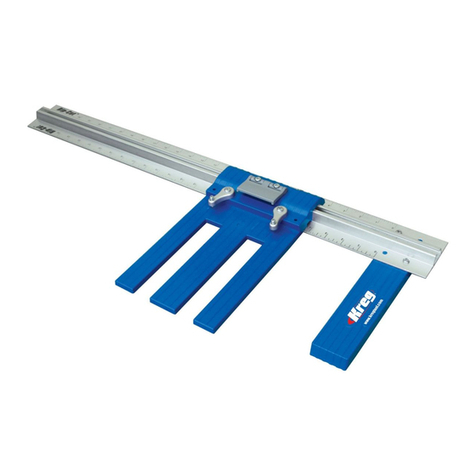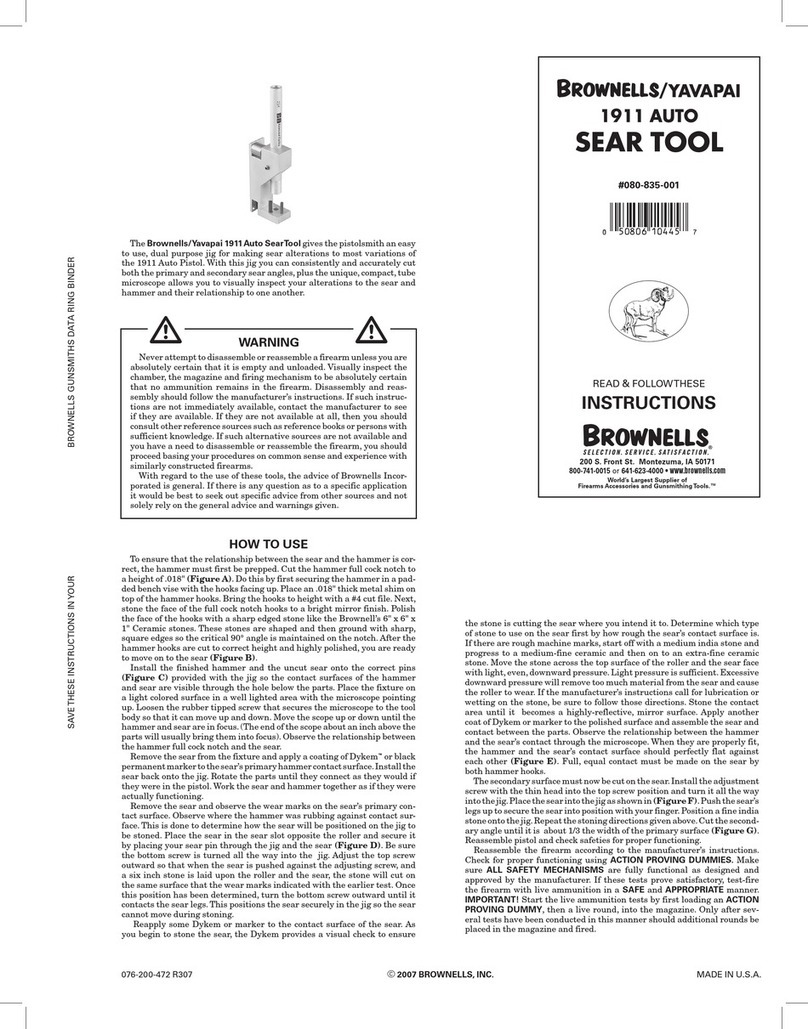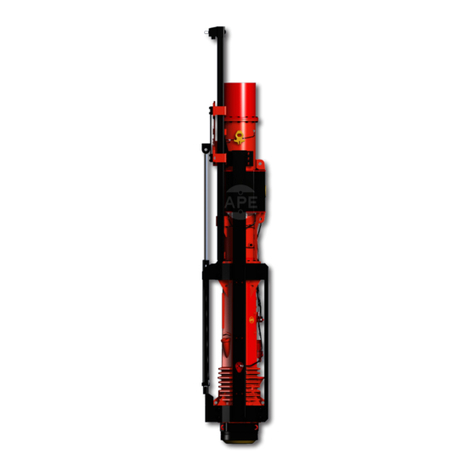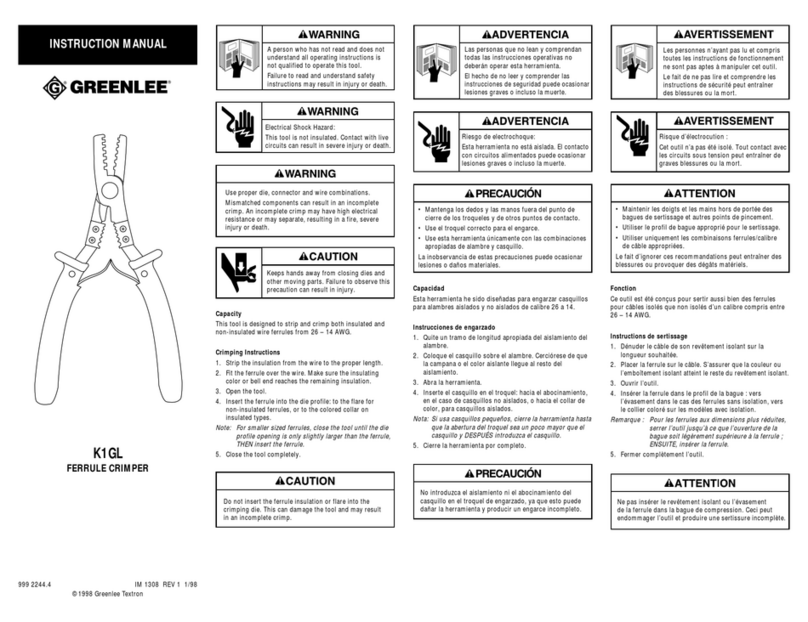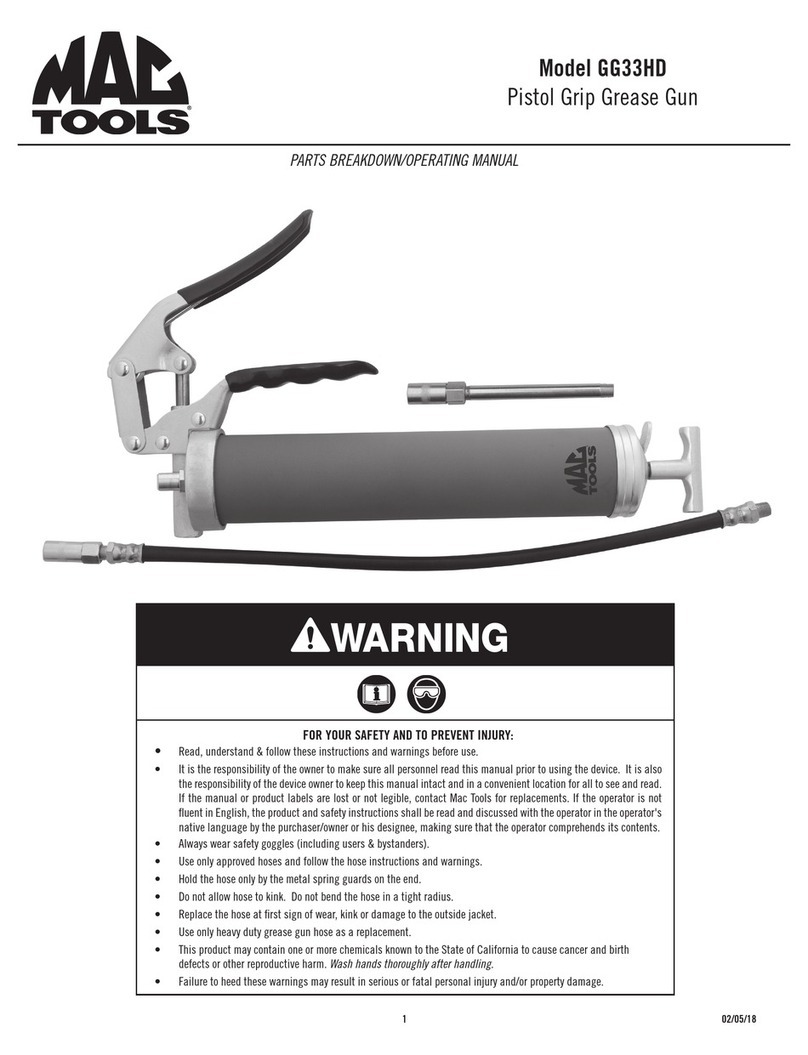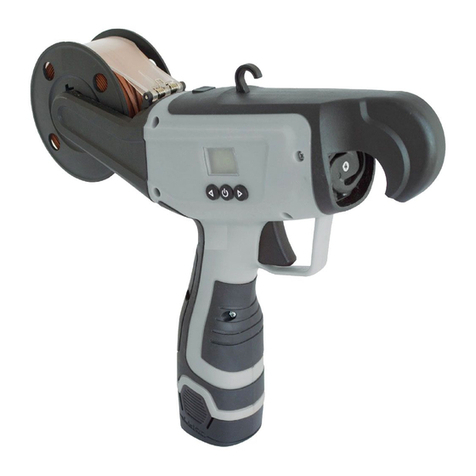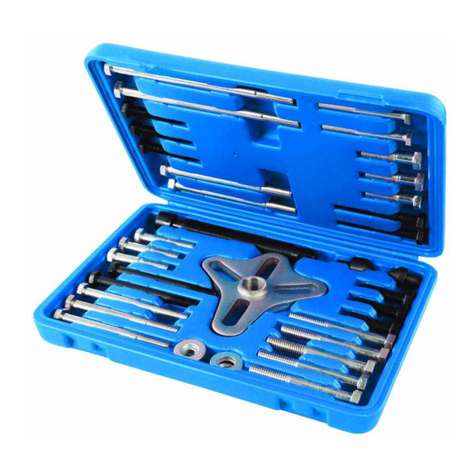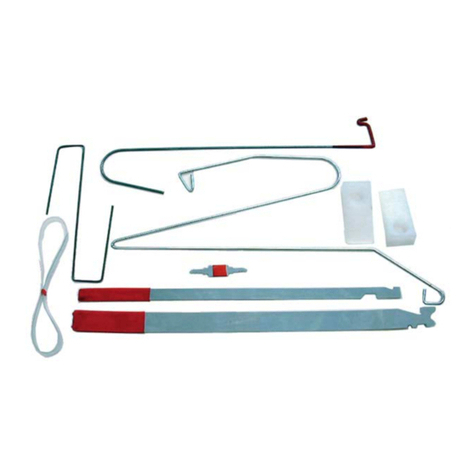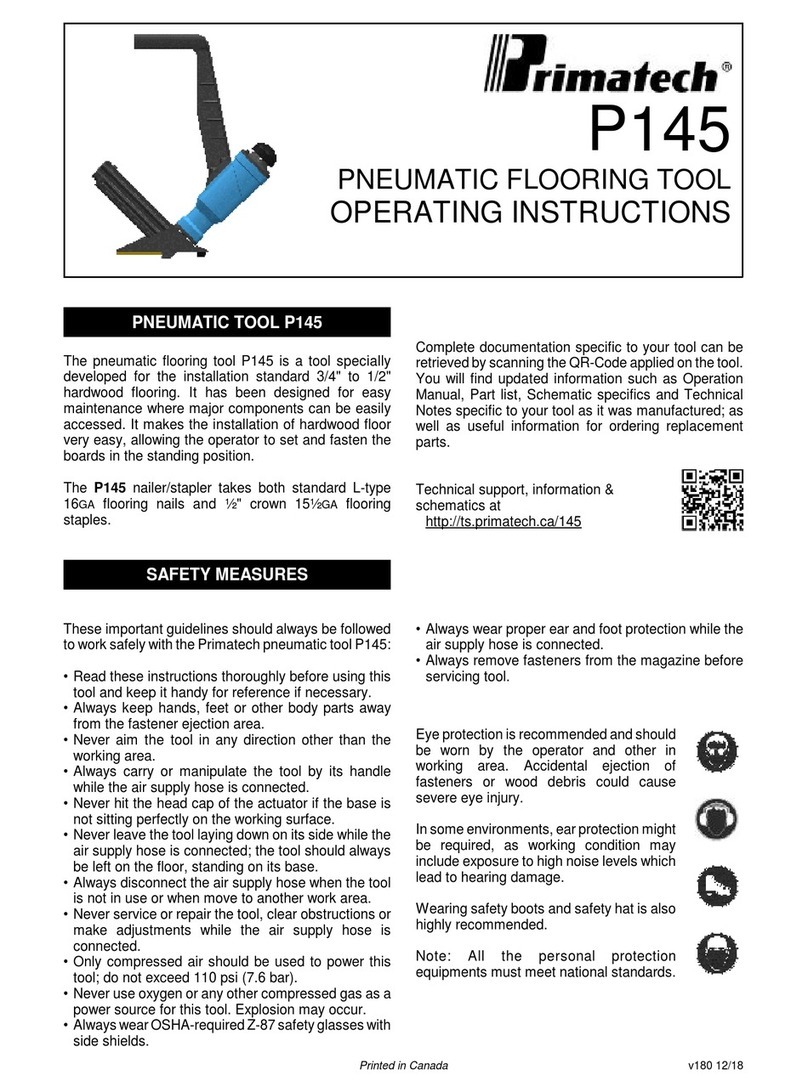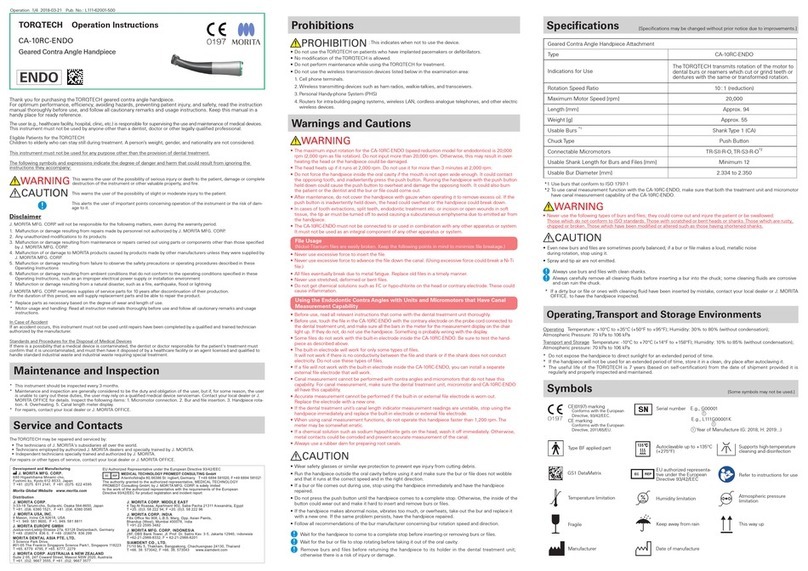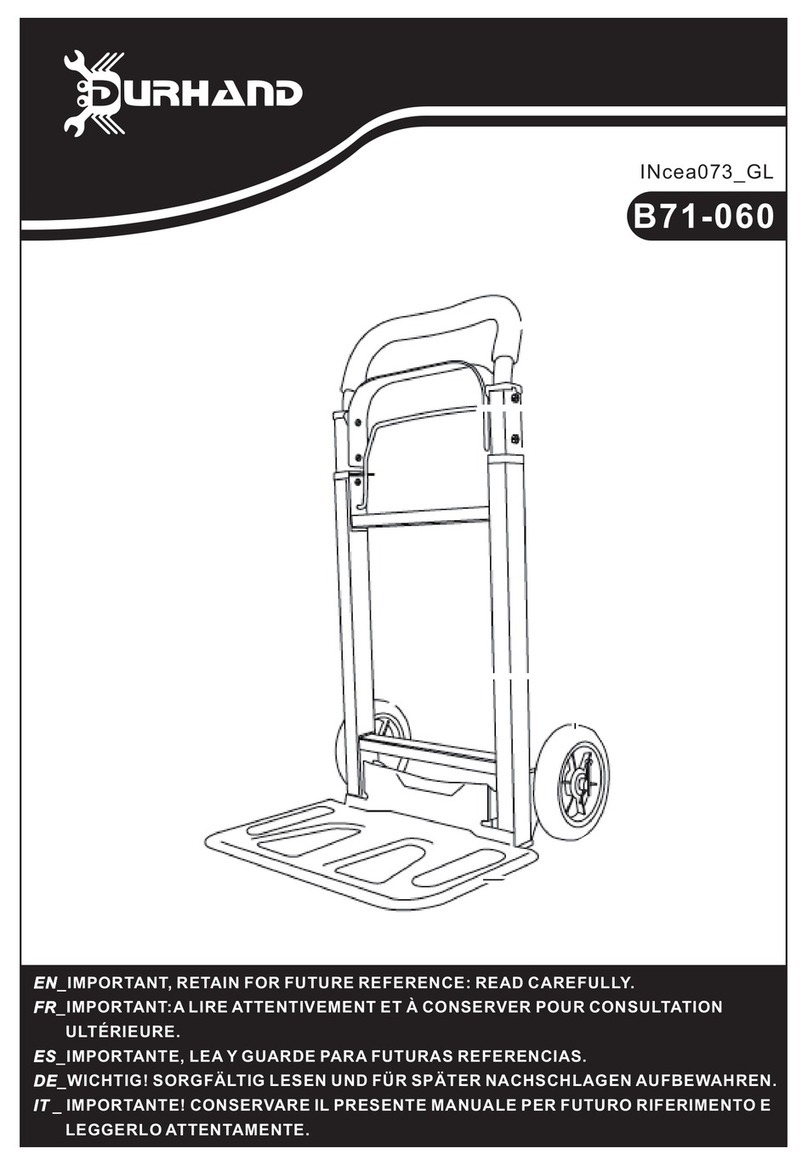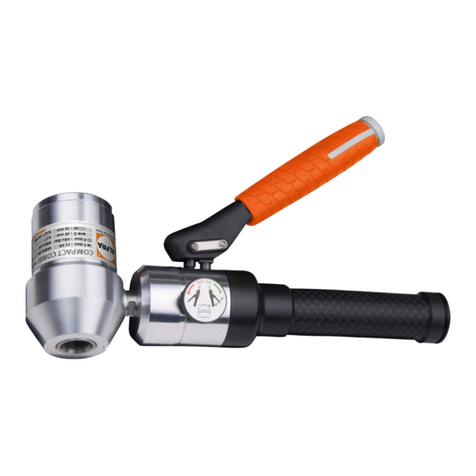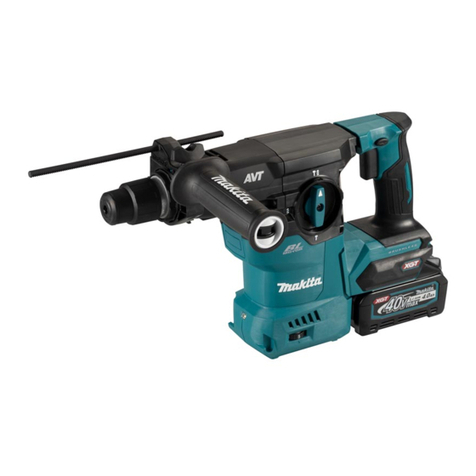SPX 1526 User manual

Sheet No.
Issue Date: Rev. E, 8-13-04
© SPX Corporation 2003
Form No. 519509
1 of 2
Parts List and
Operating Instructions
for: 1526
SPX Corporation
655 Eisenhower Drive
Owatonna, MN 55060-0995 USA
Phone: (507) 455-7000
Tech. Serv.: (800) 533-6127
Fax: (800) 955-8329
Order Entry: (800) 533-6127
Fax: (800) 283-8665
International Sales: (507) 455-7223
Fax: (507) 455-7063
Two Speed Service Jack
Max. Capacity: 3-1/2 Tons
Application: Designed to lift a wide range of motor vehicles.
Item Part
No. No. Qty. Description
1520268 1 Saddle
2520265 2 Lift Arm Return Springs
3520269 1 Hydraulic Pump
4520264 1 Handle Assembly
5520262 1 Handle Retaining Nut
6520263 1 Handle Return Spring
7520266 1 Caster Assembly
8520267 1 Wheel Assembly
9520454 1 Plate/Pull Rod Repl. Kit
10 520457 2 Long Linkage Arm Repl. Kit
Parts List
Item Part
No. No. Qty. Description
10 520457 2 Long Linkage Arm Repl. Kit
11 520458 1 Main Pivot Shaft Repl. Kit
12 520456 1 Load Block Repl. Kit
13 520455 1 Handle Socket Repl. Kit
14 524476 1 Rubber Saddle Pad
Shown on Next Page :
520270 1 Hydraulic Seal Repair Kit
520271 1 U-joint
12
3
4
4
4
5
6
7
7
7
8
8
8
1
10
10
10
11
11
10 10
12 12
9
9
999
13
13
13
14

Parts List & Operating Instructions Form No. 519509, Back of Sheet 1 of 2
Item
No. Qty. Description
No. 520270 Hyd. Seal Kit includes :
1 1 O-ring
2 1 O-ring
3 1 O-ring
4 1 Plug Screw
5 1 O-ring
6 1 O-ring Retainer
7 1 O-ring
8 1 Copper Washer
9 1 O-ring
10 2 O-ring
11 1 Washer
12 2 Filter Screen
13 1 Copper Washer
14 2 O-ring
36 2 Backup Ring
No. 520271 U-joint Kit includes :
15 1 Ball
16 1 O-ring
17 1 Release Assembly
1
2
3
45
6
7
8
9
10
11
12
13
14
15 16
17
Bleeding Air from the System
Air can accumulate within a hydraulic system during shipment or if the oil supply runs too low. This entrapped air causes
the jack to respond slowly or feel “spongy.” The following procedure bleeds air from the system.
1. Remove the jack from service, and place it on a level surface.
2. Open the release valve by turning the handle all the way counterclockwise (CCW).
3. Pump the handle six full strokes.
4. Close the release valve by turning the handle all the way clockwise (CW).
5. Pump the handle until the lift arm is fully extended.
6. Lower the lift arm by turning the handle all the way counterclockwise (CCW).
7. Test the jack for normal operation. If the lift pad doesn’t rise to the correct height, repeat Steps 2–6. If this doesn’ t solve
the problem, call the OTC Technical Services Dept. at (800) 533-6127.
36
28
29
Item
No. Qty. Description
No. 520466 Hyd. Hardware Kit
includes :
18 1 Retaining Ring
19 1 Screw
20 1 Spring
21 3 Ball
22 1 Rod
23 2 Screw
24 1 Spring
25 2 Ball
26 1 Rod
27 2 Ball
Item
No. Qty. Description
No. 520467 Hyd. Pump Station Kit includes :
13 1 Copper Washer
28 1 High Plunger
29 1 Metal Washer
30 1 Lower Protection Sleeve
31 1 Spring
32 1 Upper Protection Sleeve
33 1 Connection Washer
34 1 Cotter Pin
35 1 Plunger
36 2 Backup Ring
14 2 O-ring
18
24
22
21 20 19
30
31
32
23
25
27
21
33
34
35
23
25
26
27
21

Sheet No.
Issue Date: Rev. E, 8-13-04
© SPX Corporation 2003
Parts List & Operating Instructions Form No. 519509
Safety Precautions
CAUTION: To prevent personal injury and damage to equipment,
•Read, understand, and follow all instructions, including ASME PALD Part 10 for service jacks.
If the operator cannot read English, operating instructions and safety precautions must be
read and discussed in the operator’s native language.
–Si el operador no puede leer inglés, las instrucciones de operación y las precauciones de
seguridad deberán leerse y comentarse en el idioma nativo del operador.
– Si l’utilisateur ne peut lire l’anglais, les instructions et les consignes de sécurité doivent
lui être expliquées dans sa langue maternelle.
•Before using the service jack to lift a vehicle, refer to the vehicle service manual to determine
recommended lifting surfaces on the vehicle chassis.
•Wear eye protection that meets ANSI Z87.1 and OSHA standards.
•Inspect the jack before each use; do not use the jack if it’s damaged, altered, or in poor
condition. Take corrective action if any of the following conditions are found: cracked or
damaged housing; excessive wear, bending, or other damage; leaking hydraulic fluid;
scored or damaged piston rod; loose hardware; modified or altered equipment.
•A load must never exceed the rated lifting capacity of the jack.
•Use the jack on a hard, level surface. The jack must be free to roll without any obstructions
while lifting or lowering the vehicle. The wheels of the vehicle must be in the straight-ahead
position, and the hand brake released.
•Use the jack for lifting purposes only. Stay clear of a lifted load. Place support stands under
the axles before working on the vehicle.
•Center the load on the jack saddle. Off-center loads can damage seals and cause jack failure. Lift only dead
weight.
•Do not use blocks or other extenders between the saddle and the load being lifted.
•Do not modify the jack or use adapters unless approved or supplied by OTC.
•Lower the jack slowly and carefully while watching the position of the jack saddle.
•Use only automatic transmission fluid. The use of alcohol, hydraulic brake fluid, or transmission oil could
damage seals and result in jack failure.
This guide cannot cover every situation, so always do the job with safety first.
Operating Instructions
Setup
1. Loosen the screw on the front of the handle socket.
2. Grease the socket opening. Insert the handle.
3. Torque the screw to 120 in. lbs.
Operation
1. Close the release valve by turning the handle clockwise (CW) as far as it will go.
2. Position the jack under the vehicle. IMPORTANT: Use the manufacturer’s recommended lifting points on the
chassis.
3. Pump the jack handle to raise the saddle to the contact point.
3. Check the placement of the jack; the load must be centered on the jack saddle. IMPORTANT: Avoid wheel
obstructions such as gravel, tools, or uneven expansion joints.
4. Finish lifting the vehicle by pumping the handle. Do not attempt to raise the jack beyond its travel stops.
5. Place approved support stands under the vehicle at points that will provide stable support. Before making repairs on
the vehicle, lower it onto the support stands by SLOWLY and CAREFULLY turning the handle counterclockwise (CCW).
2 of 2

Parts List & Operating Instructions Form No. 519509, Back of Sheet 2 of 2
Preventive Maintenance
IMPORTANT: The greatest single cause of failure in hydraulic units is dirt. Keep the service jack clean and well
lubricated to prevent foreign matter from entering the system. If the jack has been exposed to rain, snow, sand, or grit, it
must be cleaned before it is used.
1. Store the jack in a well-protected area where it will not be exposed to corrosive vapors, abrasive dust, or any other
harmful elements.
2. Regularly lubricate the moving parts in the wheels, arm, and handle.
3. Replace the oil in the reservoir at least once per year. To check the oil level, lower the lift arm completely. Remove the
rubber filler plug. Oil level should be at the bottom of the filler plug hole. If necessary, add automatic transmission fluid,
and install the filler plug. IMPORTANT: The use of alcohol or hydraulic brake fluid could damage the seals and
result in jack failure.
4. Inspect the jack before each use. Take corrective action if any of the following problems are found:
a. cracked, damaged housing c. leaking hydraulic fluid e. loose hardware
b. excessive wear, bending, other damage d. scored, damaged piston rod f. modified equipment
5. Keep warning labels and instructional decals clean and readable. Use a mild soap solution to wash external surfaces
of the jack.
Troubleshooting Guide
Repair procedures must be performed in a dirt-free environment by qualified personnel who are familiar with this
equipment. CAUTION: All inspection, maintenance, and repair procedures must be performed when the jack is free
of a load (not in use).
Trouble Cause Solution
Jack does not lift
Jack lifts only partially
Jack advances slowly
Jack lifts load, but doesn't hold
Jack leaks oil
Jack will not retract
Jack retracts slowly
1. Release valve is open.
2. Low/no oil in reservoir.
3. Air-locked system.
4. Load is above capacity of jack.
5. Delivery valve and/or bypass valve not
working correctly.
6. Packing worn out or defective.
1. Close release valve.
2. Fill with automatic transmission fluid and
bleed system.
3. Bleed system. (See “Bleeding Air from
the system” on back of page 1.)
4. Use correct equipment.
5. Clean to remove dirt or foreign matter.
Replace oil.
6. Replace packing.
1. Too much or not enough oil.
1. Check oil level.
1. Pump not working correctly.
2. Leaking seals.
1. Rework pump.
2. Replace seals. (Seal kit No. 520270 is
available from OTC.)
1. Cylinder packing is leaking.
2. Valve not working correctly (suction,
delivery, release, or bypass).
3. Air-locked system.
1. Replace packing.
2. Inspect valves. Replace if necessary.
3. Bleed system.
1. Worn or damaged seals.
1. Replace seals.
1. Release valve is closed.
1. Open release valve all the way
counterclockwise (CCW). May be
necessary to clean release valve.
1. Cylinder damaged internally.
2. Return spring(s) is damaged.
3. Link section is binding.
1. Send jack to OTC-authorized service
center. (Refer to OTC Form No. 104060.)
2. Replace return spring(s).
3. Lubricate link sections.
Other SPX Tools manuals
